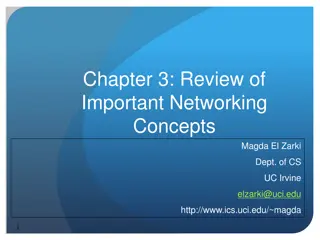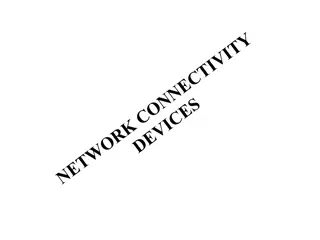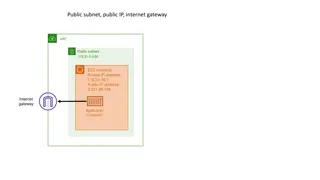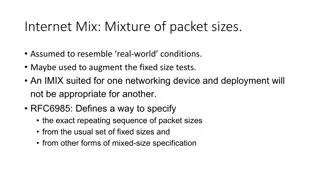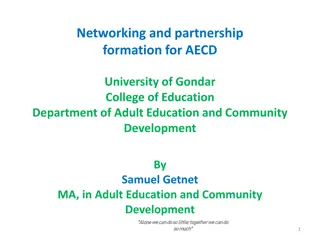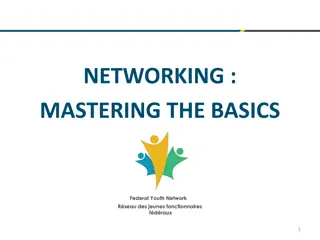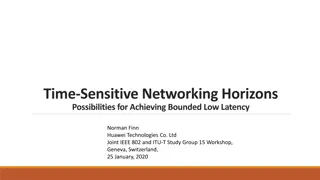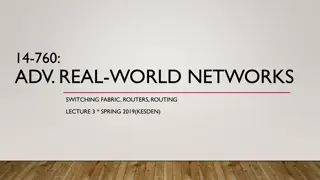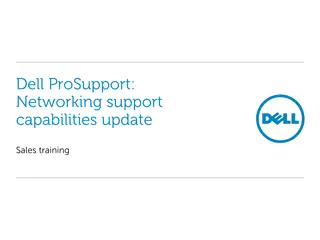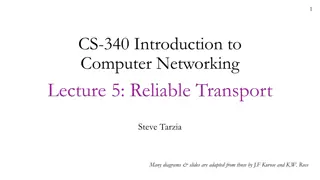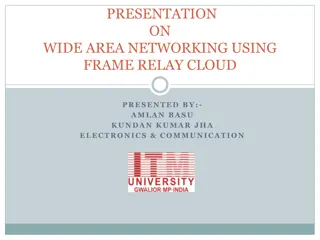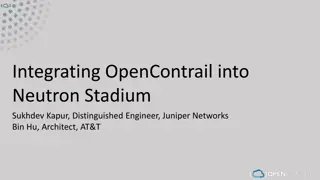Understanding IP Networking Fundamentals
Dive into the world of network layer protocols with a focus on IP, NAT, ICMP, and IPv6. Explore concepts like fragmentation, reassembly, datagram formats, addressing, and subnets, essential for grasping how data is transmitted across networks efficiently and securely.
Download Presentation

Please find below an Image/Link to download the presentation.
The content on the website is provided AS IS for your information and personal use only. It may not be sold, licensed, or shared on other websites without obtaining consent from the author. Download presentation by click this link. If you encounter any issues during the download, it is possible that the publisher has removed the file from their server.
E N D
Presentation Transcript
12 IP, NAT, ICMP, IPv6 4-1 Network Layer
IP Fragmentation & Reassembly network links have MTU (max.transfer size) - largest possible link-layer frame. different link types, different MTUs large IP datagram divided ( fragmented ) within net one datagram becomes several datagrams reassembled only at final destination IP header bits used to identify, order related fragments fragmentation: in: one large datagram out: 3 smaller datagrams reassembly 4-2
IP datagram format IP protocol version 32 bits total datagram length (bytes) number header length (bytes) type of data type of service head. len length fragment offset ver for fragmentation/ reassembly flgs 16-bit identifier time to live max number remaining hops (decremented at each router) upper layer header checksum 32 bit source IP address 32 bit destination IP address upper layer protocol to deliver payload to E.g. timestamp, record route taken, specify list of routers to visit. Options (if any) data (variable length, typically a TCP or UDP segment) 4-3
IP Fragmentation and Reassembly length =4000 ID =x fragflag =0 offset =0 Example 4000 byte datagram MTU = 1500 bytes One large datagram becomes several smaller datagrams length =1500 ID =x fragflag =1 offset =0 1480 bytes in data field length =1500 ID =x fragflag =1 offset =185 offset = 1480/8 length =1040 ID =x fragflag =0 offset =370 4-4
IP Addressing: introduction IP address: 32-bit identifier for host, router interface interface: connection between host/router and physical link router s typically have multiple interfaces host typically has one interface IP addresses associated with each interface 223.1.1.1 223.1.2.1 223.1.1.2 223.1.2.9 223.1.1.4 223.1.2.2 223.1.3.27 223.1.1.3 223.1.3.2 223.1.3.1 223.1.1.1 = 11011111 00000001 00000001 00000001 223 1 1 1 4-5
Subnets IP address: subnet part (high order bits) host part (low order bits) What s a subnet ? device interfaces with same subnet part of IP address can physically reach each other without intervening router 223.1.1.1 223.1.2.1 223.1.1.2 223.1.2.9 223.1.1.4 223.1.2.2 223.1.1.3 223.1.3.27 subnet 223.1.3.2 223.1.3.1 network consisting of 3 subnets 4-6
Subnets 223.1.1.0/24 223.1.2.0/24 Recipe to determine the subnets, detach each interface from its host or router, creating islands of isolated networks each isolated network is called a subnet. 223.1.3.0/24 Subnet mask: /24 (leftmost 24 bits determine the subnet) 4-7
Subnets 223.1.1.2 How many? 223.1.1.1 223.1.1.4 223.1.1.3 223.1.7.0 223.1.9.2 223.1.9.1 223.1.7.1 223.1.8.1 223.1.8.0 223.1.2.6 223.1.3.27 223.1.2.1 223.1.2.2 223.1.3.1 223.1.3.2 4-8
IP addressing: CIDR CIDR: Classless InterDomain Routing subnet portion of address of arbitrary length address format: a.b.c.d/x, where x is # bits in subnet portion of address host part subnet part 11001000 00010111 00010000 00000000 200.23.16.0/23 4-9
IP addresses: how to get one? Q: How does a host get IP address? hard-coded by system admin in a file UNIX: /etc/hosts DHCP: Dynamic Host Configuration Protocol: dynamically get address from a server plug-and-play 4-10
DHCP: Dynamic Host Configuration Protocol Goal: allow host to dynamically obtain its IP address from network server when it joins network DHCP overview: host broadcasts DHCP discover msg [optional] DHCP server responds with DHCP offer msg [optional] host requests IP address: DHCP request msg DHCP server sends address: DHCP ack msg 4-11
DHCP client-server scenario A 223.1.2.1 DHCP server 223.1.1.1 223.1.1.2 223.1.2.9 223.1.1.4 B arriving DHCP client needs address in this network 223.1.2.2 E 223.1.1.3 223.1.3.27 223.1.3.2 223.1.3.1 4-12
DHCP client-server scenario arriving client DHCP server: 223.1.2.5 DHCP discover src : 0.0.0.0, 68 dest.: 255.255.255.255,67 yiaddr: 0.0.0.0 transaction ID: 654 DHCP offer src: 223.1.2.5, 67 dest: 255.255.255.255, 68 yiaddrr: 223.1.2.4 transaction ID: 654 Lifetime: 3600 secs DHCP request src: 0.0.0.0, 68 dest:: 255.255.255.255, 67 yiaddrr: 223.1.2.4 transaction ID: 655 Lifetime: 3600 secs time DHCP ACK src: 223.1.2.5, 67 dest: 255.255.255.255, 68 yiaddrr: 223.1.2.4 transaction ID: 655 Lifetime: 3600 secs 4-13
IP addresses: how to get one? Q: How does network get subnet part of IP addr? A: gets allocated portion of its provider ISP s address space ISP's block 11001000 00010111 00010000 00000000 200.23.16.0/20 Organization 0 11001000 00010111 00010000 00000000 200.23.16.0/23 Organization 1 11001000 00010111 00010010 00000000 200.23.18.0/23 Organization 2 11001000 00010111 00010100 00000000 200.23.20.0/23 ... .. . . Organization 7 11001000 00010111 00011110 00000000 200.23.30.0/23 4-14
Hierarchical addressing: route aggregation Hierarchical addressing allows efficient advertisement of routing information: Organization 0 200.23.16.0/23 Organization 1 Send me anything with addresses beginning 200.23.16.0/20 200.23.18.0/23 Organization 2 ... 200.23.20.0/23 Fly-By-Night-ISP ... Internet Organization 7 200.23.30.0/23 Send me anything with addresses beginning 199.31.0.0/16 ISPs-R-Us 4-15
Hierarchical addressing: more specific routes ISPs-R-Us has a more specific route to Organization 1 Organization 0 200.23.16.0/23 Send me anything with addresses beginning 200.23.16.0/20 Organization 2 ... 200.23.20.0/23 Fly-By-Night-ISP ... Internet Organization 7 200.23.30.0/23 Send me anything with addresses beginning 199.31.0.0/16 or 200.23.18.0/23 ISPs-R-Us Organization 1 200.23.18.0/23 4-16
IP addressing: the last word... Q: How does an ISP get block of addresses? A: ICANN: Internet Corporation for Assigned Names and Numbers allocates addresses manages DNS assigns domain names, resolves disputes 4-17
NAT: Network Address Translation rest of Internet local network (e.g., home network) 10.0.0/24 10.0.0.1 10.0.0.4 10.0.0.2 138.76.29.7 10.0.0.3 Datagrams with source or destination in this network have 10.0.0/24 address for source, destination (as usual) All datagrams leaving local network have same single source NAT IP address: 138.76.29.7, different source port numbers 4-18
NAT: Network Address Translation Motivation: local network uses just one IP address as far as outside world is concerned: range of addresses not needed from ISP: just one IP address for all devices can change addresses of devices in local network without notifying outside world can change ISP without changing addresses of devices in local network devices inside local net not explicitly addressable, visible by outside world (a security plus). 4-19
NAT: Network Address Translation Implementation: NAT router must: outgoing datagrams:replace (source IP address, port #) of every outgoing datagram to (NAT IP address, new port #) . . . remote clients/servers will respond using (NAT IP address, new port #) as destination addr. remember (in NAT translation table) every (source IP address, port #) to (NAT IP address, new port #) translation pair incoming datagrams:replace (NAT IP address, new port #) in dest fields of every incoming datagram with corresponding (source IP address, port #) stored in NAT table 4-20
NAT: Network Address Translation NAT translation table WAN side addr LAN side addr 138.76.29.7, 5001 10.0.0.1, 3345 1: host 10.0.0.1 sends datagram to 128.119.40.186, 80 2: NAT router changes datagram source addr from 10.0.0.1, 3345 to 138.76.29.7, 5001, updates table S: 10.0.0.1, 3345 D: 128.119.40.186, 80 10.0.0.1 1 S: 138.76.29.7, 5001 D: 128.119.40.186, 80 2 10.0.0.4 10.0.0.2 138.76.29.7 S: 128.119.40.186, 80 D: 10.0.0.1, 3345 4 S: 128.119.40.186, 80 D: 138.76.29.7, 5001 3: Reply arrives dest. address: 138.76.29.7, 5001 3 10.0.0.3 4: NAT router changes datagram dest addr from 138.76.29.7, 5001 to 10.0.0.1, 3345 4-21
NAT: Network Address Translation 16-bit port-number field: 60,000 simultaneous connections with a single LAN-side address! NAT is controversial: routers should only process up to layer 3 violates end-to-end argument NAT possibility must be taken into account by app designers, e.g., P2P applications address shortage should instead be solved by IPv6 4-22
ICMP: Internet Control Message Protocol used by hosts & routers to communicate network-level information error reporting: unreachable host, network, port, protocol echo request/reply (used by ping) network-layer above IP: ICMP msgs carried in IP datagrams ICMP message: type, code plus first 8 bytes of IP datagram causing error Type Code description 0 0 echo reply (ping) 3 0 dest. network unreachable 3 1 dest host unreachable 3 2 dest protocol unreachable 3 3 dest port unreachable 3 6 dest network unknown 3 7 dest host unknown 4 0 source quench (congestion control - not used) 8 0 echo request (ping) 9 0 route advertisement 10 0 router discovery 11 0 TTL expired 12 0 bad IP header 4-23
Traceroute and ICMP Source sends series of UDP segments to dest first has TTL =1 second has TTL=2, etc. unlikely port number When nth datagram arrives to nth router: router discards datagram and sends to source an ICMP message (type 11, code 0) ICMP message includes name of router & IP address when ICMP message arrives, source calculates RTT traceroute does this 3 times Stopping criterion UDP segment eventually arrives at destination host destination returns ICMP port unreachable packet (type 3, code 3) when source gets this ICMP, stops. 4-24
IPv6 Initial motivation:32-bit address space soon to be completely allocated. Additional motivation: header format helps speed processing/forwarding header changes to facilitate QoS IPv6 datagram format: fixed-length 40 byte header no fragmentation allowed 4-25
IPv6 Header (Cont) Priority: identify priority among datagrams in flow Flow Label:identify datagrams in same flow. (concept of flow not well defined). Next header: identify upper layer protocol for data pri ver flow label hop limit payload len next hdr source address (128 bits) destination address (128 bits) data 32 bits 4-26
Other Changes from IPv4 Checksum:removed entirely to reduce processing time at each hop Options: allowed, but outside of header, indicated by Next Header field ICMPv6: new version of ICMP additional message types, e.g. Packet Too Big multicast group management functions 4-27
Transition From IPv4 To IPv6 Not all routers can be upgraded simultaneous no flag days How will the network operate with mixed IPv4 and IPv6 routers? Tunneling: IPv6 carried as payload in IPv4 datagram among IPv4 routers 4-28



